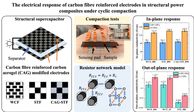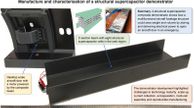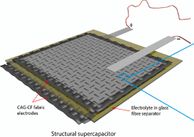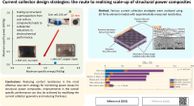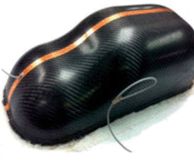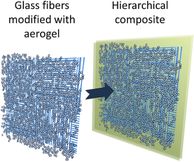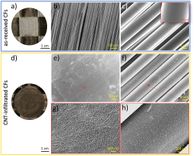Highlights
This is a selection of publications from the Structural Power Composites Group. For a full list of publications, please see below.
Highlights
Results
- Showing results for:
- Reset all filters
Search results
-
Journal articleShirshova N, Qian H, Shaffer MSP, et al., 2013,
Structural composite supercapacitors
, Composites Part A: Applied Science and Manufacturing, Vol: 46, Pages: 96-107, ISSN: 1359-835XThis paper presents the development of multifunctional materials that perform a structural role whilst simultaneously storing electrical energy as a supercapacitor. Two structural carbon fibre woven electrodeswere separated by a woven glass fibre layer, and infused with a multifunctional polymer electrolyte. Following characterisation of electrochemical and compressive performance, working structural supercapacitor prototypes were demonstrated. Since the relative mechanical and electrical demands are application specific, an optimisation methodology is proposed. Multifunctional composites were achieved, which had compressive moduli of up to 39 GPa and capacitances of up to 52 mF g 1.
-
Conference paperBismarck A, Carreyette S, Fontana QPV, et al., 2012,
Multifunctional epoxy resin for structural supercapacitors
, 15th European Conference on Composite Materials, Publisher: European Socirty for Composite Materials, Pages: 1-8Polymer-based electrolytes based on commercially available epoxy resins were prepared through the addition of a liquid electrolyte, a solution of a lithium salt in an ionic liquid. The polymer monoliths were characterized using impedance spectroscopy, 3-point bending test, scanning electron microscopy (SEM) and nitrogen adsorption (BET). The balance of ionic conductivity and flexural modulus is crucially dependent on the relative proportions of epoxy resin to electrolyte. Also the effect of the liquid electrolyte on curing kinetics and processing was assessed by complex viscosity measurements and differential scanning calorimetry (DSC). Only one out of the three resins investigated exhibited a significant acceleration effect.
-
Journal articleQian H, Diao HL, Houllé M, et al., 2012,
Carbon fibre modifications for composite structural power devices
, ECCM 2012 - Composites at Venice, Proceedings of the 15th European Conference on Composite MaterialsThis research project focuses on the development of new multifunctional composite materials, which allow energy storage functionality to be imbued upon low weight structural components. A crucial requirement for efficient structural energy storage composites is the development of structural carbon fibre electrode materials that possess high electrochemical surface area and stability whilst supporting high mechanical loads. In the present work, a variety of carbon fibre modifications were investigated, including chemical activation, carbon nanotube (CNT) sizing and CNT-grafting. The effects of these different modification methods on the fibre surface microstructure, electrochemical, and mechanical performance were studied and compared. In the most promising cases, up to a hundred-fold improvement in electrical storage capacity was achieved. Furthermore, single fibre tensile tests demonstrated that the intrinsically excellent mechanical properties of the carbon fibre were retained after the modifications.
-
Journal articleGreenhalgh ES, 2012,
Structural power composites for hybrid vehicles (storage)
, ECCM 2012 - Composites at Venice, Proceedings of the 15th European Conference on Composite MaterialsComposite engineers have made considerable strides forward in the development of new constituents, architectures and processing routes, leading to an unprecedented ability to tailor and optimise the properties of the resulting composites. Recently there has been interest in developing multifunctional materials which exhibit duel, and distinctly different, capabilities. Structural power composites; multifunctional materials that carry mechanical loads whilst storing (and delivering) electrical energy, are the focus of this paper. The progress made by the STORAGE consortium, who have been using structural power materials for hybrid automotive applications, is presented. In particular, the progress made in the constituent development, the resulting composites, systems and demonstration is discussed.
-
Journal articleWienrich M, Kalinka G, Greenhalgh ES, et al., 2012,
Impact of ionic liquid on the mechanical performance of matrix polymer for fibre reinforced materials for energy storage
, ECCM 2012 - Composites at Venice, Proceedings of the 15th European Conference on Composite MaterialsFor the concept of using structural materials such as carbon fibre reinforced plastics as energy storage devices, new matrix polymers are required. These polymers must provide ionic conductivity as well as adequate mechanical strength. In the EU-Project StorAGE this requirements are fulfilled by adding ionic liquid to commercial polymers. The mechanical properties of these mixtures materials were characterized by using a 3-point-bending device. In addition, single fibre pull test were performed in order to get information on the interfacial shear strength. Adding of ionic liquid has an impact on the mechanical performance of the materials. A decrease of the flexural strength and modulus of less than 10% of the value of the reference materials took part. The interfacial shear strength decreased to a value of around one third compare to the reference material.
-
Conference paperShirshova N, Shaffer M, Steinke JHG, et al., 2011,
Structural Polymer Composites for Energy Storage Devices
, International Conference on Advanced Capacitors (ICAC2007) -
Journal articleGreenhalgh ES, 2011,
Storage solutions
, MATERIALS WORLD, Vol: 19, Pages: 24-26, ISSN: 0967-8638- Author Web Link
- Cite
- Citations: 1
-
Conference paperShirshova N, Shaffer M, Steinke JHG, et al., 2011,
Strutural Polymer Composites for Energy Storage Devices
, 1st Chemical and Biomedical Engineering Symposium -
Journal articleQian H, Kalinka G, Chan KLA, et al., 2011,
Mapping local microstructure and mechanical performance around carbon nanotube grafted silica fibres: Methodologies for hierarchical composites
, NANOSCALE, Vol: 3, Pages: 4759-4767, ISSN: 2040-3364- Author Web Link
- Cite
- Citations: 35
-
Conference paperSnyder J, Gienger E, Wetzel E, et al., 2010,
Multifunctional Structural Composite Supercapacitors
, Proceedings of 27th U.S. Army Science Conference. -We are developing structural polymeric composites with supercapacitor functionality. These devices carry structural loads while simultaneously storing electrochemical energy. If designed with sufficient structural and energy efficiency, these materials could enable significant system-level weight reductions by replacing inert structural components while providing supplementary power for light load applications. To enable this concept, we have designed mechanical loadbearing properties directly into the supercapacitor electrodes and electrolyte such that each component is itself multifunctional. Several electrode types are evaluated here for multifunctional properties in a structural composite supercapacitor configuration. The resulting supercapacitor composites have been characterized to quantifiably compare changes in materials and processing, including tensile and shear tests to assess mechanical properties, and cyclic voltammetry to assess energy storage behavior.
-
Journal articleQian H, Greenhalgh ES, Shaffer MSP, et al., 2010,
Carbon nanotube-based hierarchical composites: a review
, Journal of Materials ChemistryThe introduction of carbon nanotubes (CNTs) into conventional fibre-reinforced polymer composites creates a hierarchical reinforcement structure and can significantly improve composite performance. This paper reviews the progress to date towards the creation of fibre reinforced (hierarchical) nanocomposites and assesses the potential for a new generation of advanced multifunctional materials. Two alternative strategies for forming CNT-based hierarchical composites are contrasted, the dispersion of CNTs into the composite matrix and their direct attachment onto the primary fibre surface. The implications of each approach for composite processing and performance are discussed, along with a summary of the measured improvements in the mechanical, electrical and thermal properties of the resulting hierarchical composites.
-
Conference paperShirshova N, Greenhalgh ES, Shaffer M, et al., 2009,
Structured Multifunctional Composites for Power Storage Devices
, 17th International Conference on Composite Materials -
Conference paperShirshova N, Greenhalgh E, Shaffer M, et al., 2009,
Structured multifunctional composites for power storage devices
We report the fabrication and performance of multifunctional composite materials for energy storage application. The electrochemical and mechanical properties of the obtained composites were systematically studied.
-
PatentChen GZ, Fray DJ, Hughes M, et al., 2001,
Conducting polymer-carbon nanotube composite materials and their use in energy storage devices
, 2003077515
This data is extracted from the Web of Science and reproduced under a licence from Thomson Reuters. You may not copy or re-distribute this data in whole or in part without the written consent of the Science business of Thomson Reuters.
Related links
Contact
Professor Emile S Greenhalgh
Department of Aeronautics
Imperial College London
South Kensington Campus
London SW7 2AZ
+44 (0)7958 210 089
e.greenhalgh@imperial.ac.uk
